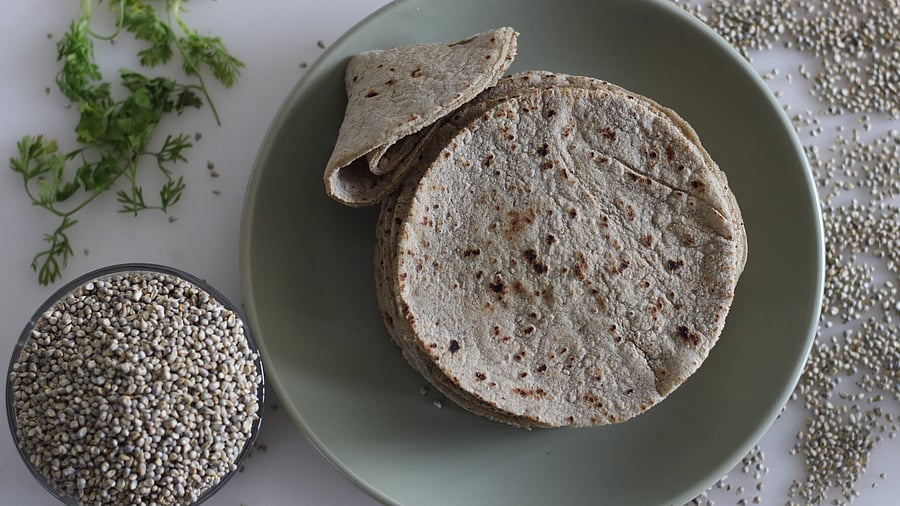
Soft flat bread made of pearl millet flour or bajra.
Credit: iStock Photo
As the global culinary fusion scene continues to evolve rapidly, the allure of exotic ingredients plays a pivotal role in shaping the future of India’s food landscape, not just in restaurants but also in homes. However, there is a growing movement advocating for the use of healthy, local alternatives that celebrate the richness and diversity of India’s agricultural heritage. This shift promotes sustainable practices and enhances our food’s nutritional value and cultural relevance. Additionally, there is a school of thought that encourages the consumption of low-calorie, high-fibre foods as part of a balanced diet. For example, the Filipino jelly, coco de nata, which is gaining popularity across the Asia-Pacific region, is favoured for its low-calorie content and high levels of insoluble dietary fibre, making it a natural fit for beverages like boba tea and Mogu Mogu. Yet, we often overlook the fact that, at the end of the day, it remains a processed food, even though its global market value has reached USD 807.4 million.
While we are familiar with common substitutes for exotic ingredients, such as using bottle gourd in place of zucchini, we must ask: What exactly drives these recommendations? Are local foods truly healthier, or are they simply preferred to reduce food miles? How can we balance familiar alternatives with a strong health profile? Why is prioritising hyperlocal and seasonal foods essential when planning our meals?
Here’s a breakdown of why and how to embrace local alternatives to gain the benefits of eating local and seasonal foods:
• Enhanced nutritional value: Locally sourced produce, consumed in season, is generally fresher and richer in nutrients. It hasn’t been subjected to extensive processing or long-distance transportation, both of which can reduce its vitamin and mineral content. Furthermore, traditional recipes typically use diverse, nutrient-rich ingredients, and revisiting these can greatly improve our health.
• Environmental sustainability: Reducing our dependence on imported ingredients cuts down on the carbon footprint associated with long-distance transportation. By supporting smallholder farmers, we also strengthen local economies and encourage sustainable agricultural practices.
• Cultural preservation: India’s culinary heritage is vast, with regional cuisines making use of a wide array of indigenous and sometimes hyper-local ingredients. Rediscovering and incorporating these ingredients into our meals helps preserve our cultural identity.
• Better flavour: Foods grown locally and consumed in season often have superior flavour. For instance, avarekai is at its best in January, and mangoes are meant to be naturally ripened and enjoyed during peak summer.
Ingredient substitutes
Here are some examples of local alternatives for exotic ingredients:
• Quinoa vs Amaranth (Rajgira) or Finger millet (Ragi): While quinoa is highly nutritious, it is not native to India. Amaranth and millets like ragi provide similar benefits, such as high protein and fibre content, and are well-suited to India’s climate.
• Arborio rice vs Gobindobhog: Gobindobhog rice is not only aromatic but also creamy enough to replicate the texture of arborio rice, which is expensive and scores high on the food mile scale.
• Coco de Nata vs Ice Apple: The jelly-like consistency of coco de nata can be mimicked with ice apple. Chop it into small pieces, chill it, and add it to beverages like boba tea or fruit salads for a refreshing twist.
• Thyme vs Ajwain: Both thyme and ajwain contain thymol and share a similar aroma and flavour. Ajwain can easily be used to add that extra zing to baked or fried recipes.
• Gherkins vs Knol Khol: Known for their distinct pickling qualities, gherkins can be substituted with knol khol. Simply cut it into strips, soak it in a vinegar and salt bath for a couple of days, and add some rock salt for a flavourful kick.
• Wasabi vs Mustard: Homemade mustard paste offers a pungency similar to wasabi, making it a versatile ingredient for salad dressings, dips for chips, or even as a sauce for sandwiches and rolls.
• Lettuce vs Rocket or other leafy greens: India boasts a variety of nutrient-rich leafy greens like rocket, spinach, methi (fenugreek), and wood sorrel, all of which can replace lettuce in salads.
• Chia seeds vs Sabja seeds: Sabja (basil) seeds are a great alternative to chia seeds, offering similar benefits like high fibre and omega-3 fatty acids. Known for their cooling properties, they are especially well-suited to India’s climate.
• Exotic berries vs Amla or Jamun: Instead of expensive imported berries, consider amla and jamun, both of which are packed with antioxidants and vitamin C.
By embracing local and seasonal ingredients, we can enjoy fresher, more nutritious meals while supporting sustainable practices and preserving our rich culinary traditions.
(Ranjini is a communications professor, author, and podcaster, straddling many other worlds, in Bengaluru. She’s passionate about urban farming and sustainable living, and can mostly be found cooking and baking in her little kitchen, where, surrounded by heirloom coffee kettles and mismatched tea cups, she finds her chi.)